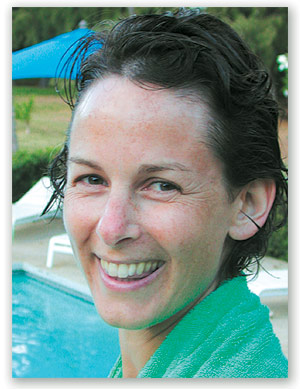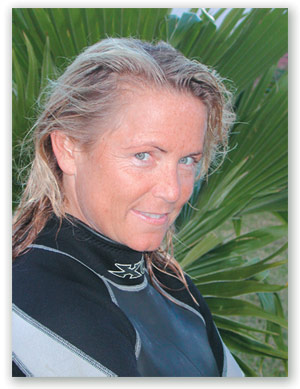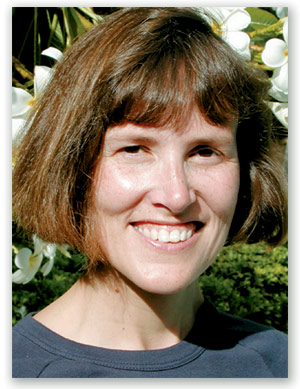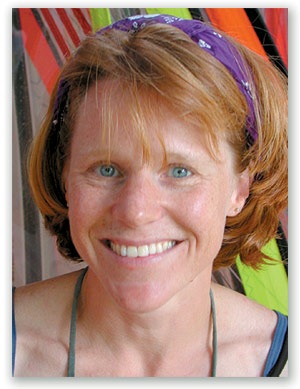In Mel Gibsons’ latest film What Women Want, his character is able to hear the innermost secrets of women without their knowledge. When you remove the scary invasion-of-privacy implications and enjoy the hilarious voyeuristic results the flick is a lot of fun. I’m not claiming to be Mel Gibson, but I too know what women want and it didn’t take a 60-million dollar movie to find out. I simply asked.
American Windsurfer: As a woman, what’s your pet peeve with windsurfing?
JODY: I hate not being able to downhaul my sail enough by myself (and of course, having to ask a man!). I like keeping it all simple, so I’m reluctant to buy those fancy new downhaul gadgets.
Barb: We look but we don’t touch each other in this sport. There is some strange code of ethics that is not always friendly to women or beginners or anyone in trouble. For example, if someone is struggling at the Hatchery, it’s just assumed that they know what they are doing. Instead of helping out we just pass each other by. Reaching out to your fellow man or woman is common courtesy.
Mary: I love to sail so it is hard to complain.
Kristen: Meeting someone new while hanging out at a windsurfing site with my husband and having them turn to me and say “Do you windsurf too?”
American Windsurfer: What prompted you to take up windsurfing?

JODY: I wanted a “simple” sport where I could load my own equipment and go whenever I wanted to.
Barb: I’m native to San Diego and grew up with salt water in my veins and always liked the idea of natural power and eliminate the need for engines. All of this became even more obvious once I broke my collar bone riding dirt bikes. I channeled all that joy of getting air and out of control speed into windsurfing. This sport is impossible to master, challenging and humbling, all in one.
Mary: A boyfriend. I decided I had better learn if I wanted to spend time with him.
Kristen: A woman friend invited me to a Teach-A-Friend weekend being sponsored by the local windsurfing club. She and another woman in the club gave me a basic lesson, which got me hooked.
American Windsurfer: When you were learning to windsurf, do you feel you received encouragement?
JODY: Definitely, I learned in Kansas and there was a great club where quite a few women were involved. Encouragement meant a lot.
Barb: Initially, yes. But as I advanced, I was dropped like a hot potato. When windsurfing first took off Matt Schweitzer established regular races and clinics and Tara Schweitzer was such an encouragement to all women and beginners.
Mary: I would go to the beginner areas and hang out with everyone else learning, we all cheered each other on. The more advanced sailors were concerned with what they were doing on the water so I don’t remember much from them.
Kristen: I meet a group of windsurfers that hung out on weekends and encouraged each other with tips. If I hadn’t known that group, it would have been easy to quit.
American Windsurfer: Were there other women learning at the same time as you? Were there other, experienced, women windsurfers around?
JODY: All the women I met originally were more experienced windsurfers, but within a few years of other women did join in.
Barb: Yeah, but they were a little heavy on the hard-core, gotta-beat-a-man style. I think I always got better advice and direction from men.
Mary: In the Gorge there were the Gorge Girls or Wind Women and they would meet to sail and socialize, they were always helpful and supportive.
Kristen: Yes to both questions. It helped a lot having other women around who could empathize with my trials and tribulations.
Advertisement
American Windsurfer: Know any women who tried to learn windsurfing, but gave up? Why?
JODY: In the Gorge, I’m friends with quite a few women who used to sail. I think the amount of equipment, cost and raising families, just conflicted too much.
Barb: I think both women and men find it difficult to learn. But, I’d rather have fewer, better sailors than a thousand newcomers who try and run away disgruntled. Too many beginners try it once and think it too hard. I always tell people in advance, “I’ll show you how but you have to come at least twice and preferably five times.”
Mary: I know a few women that tried windsurfing then quit. The reasons I hear most often are that they don’t have the time or they have family responsibilities.
Kristen: Yes. One woman got frustrated at getting stuck in an offshore wind, and talked herself out of trying it again. It’s too bad, she might have had fun if she’d tried again, but I know how frustrating that can be, how easy it would be to just say “Forget it, this is too much work!”
American Windsurfer: Where are manufacturers going wrong with their products as far as women sailors are concerned?
JODY: Boards-they are predominantly made for 180lb males, and they aren’t responsive enough for 125lb women. Most board builders are men building for men. We either need women building boards or builders listening to women and building women’s models.

Barb: Gear is for men, Period. The industry absolutely needs to better satisfy woman sailors.
Kristen: There aren’t enough products that focus on the fact that women are lighter and have a different center of balance to men. It’s not enough to say something works for a 130-pound man, why doesn’t it work for you? Women are not just small men, they sail differently and, out of necessity, tend to finesse things rather than use brute force.
American Windsurfer: Should manufacturers provide more equipment specifically for women?
JODY: A lighter rig would be great, they are so much easier to handle when they are light!
Mary: Manufactures are doing much better at providing smaller equipment for women. I think women can go to a shop and find stuff that will fit their needs, this wasn’t true 10 years ago.
Kristen: Definitely! And don’t just provide equipment specifically for women but get feedback from average women, not just the pro women sailors out there. It seems that women are not involved in the design process, you’ve got men designing equipment for women based on what they’re hearing women tell them, but any woman can tell you that men don’t really listen to women! There must be plenty of women out there who are capable of designing a sailboard.
American Windsurfer: What problems do you personally have with your windsurfing equipment?
JODY: My only issue is how hard it is to downhaul the sails.
Barb: Getting it all to work together for all the places I like to sail. For the life of me, I can’t get my harness lines right. I’m sure much of it is me, but if the gear was more compatible and less mysterious it might be easier to figure out.
Mary: I like my gear now but in the past I couldn’t find sails and boards small enough. I live in the Gorge so I need small equipment for the high winds. I finally had my boards custom made.
Kristen: I have a bad back, so downhauling the sail is the thing I have the most problems with—Advil is my downhauling aid. Other than that, I’m pretty happy with my equipment right now. In the past I’ve had trouble finding wetsuits that fit me right, harnesses that fit me, and boards that were maneuverable for an intermediate woman sailor. I’m a better windsurfer now, so I can adapt to gear deficiencies better than I used to. Some of the women’s sails are pretty nice, but I’m fairly tall and have a problem getting the boom high enough on some of them. Of course, I know short women who can’t get the boom low enough on regular sails, so what do you do?
American Windsurfer: What design changes would you like to see?
JODY: I think I covered this already
Barb: Designs by women, for women and about women; like girls boards, sails and wetsuits and harnesses. Downhaul “winches for wenches” and stuff for women based on our unique womanly dimensions and aptitudes. Not just men’s gear re-marketed as if it is also for women.
Mary: Design something that makes it easier to downhaul sails. I see a lot of men down-hauling sails for their women sailing companions.

Kristen: For the sailing conditions I’m used to (high wind bump-and-jump), I’d like to see production boards that are lighter and more maneuverable with less volume. For lower winds, I’d like a higher-volume board that handles like a smaller board, not like a barge. I’m finding sails to be pretty good but anything that makes downhauling easier without having to haul out some clunky appliance would be most appreciated. Also, many women share equipment with a husband or boyfriend, what can you do to make it easier to switch out equipment and still have it meet each person’s needs?
American Windsurfer: What good stuff for women windsurfers are companies actually producing?
JODY: Love the teensy weensy waist harnesses! Love the light sails!
Barb: I love DaKine’s use of color and patterns like flowers and things on harnesses and gear bags. They also appear to design stuff with a woman’s shape in mind. I also like the Starboard Diva board; it was obvious they are trying to suit a woman’s special sailing needs.
Mary: There are some great production boards being made for women now with narrower positioned foot straps for smaller people. We can get wetsuits and harnesses that fit, small grip booms and small sails that actually have a wind range.
Kristen: The new skinny carbon masts are nice and light, and the narrower boom grips help a lot. DaKine’s women’s waist harness is a big improvement over regular waist harnesses.
Advertisement
American Windsurfer: Are manufacturers marketing the sport of windsurfing to women?
Barb: No, it’s all smoke and mirrors and techno speak. If women, kids, newcomers and intermediates could easily understand all the pieces and how they affect each other, it would make sailing a lot more popular.
Mary: Manufacturers could do more to market the sport to women. Often advertisements for equipment have pictures of extreme sailors getting huge air and hanging upside-down. Many women have no desire to do that. The beauty of windsurfing is it can be as extreme as you want it . . . you don’t have to loop to have a good time.
Kristen: No. I look through windsurfing magazines and all I see are big macho guys doing big macho loops on big macho equipment. When I see a woman, she’s in a tiny bikini on a big beginner board with some big macho guy teaching her how to windsurf, or she’s just modeling a fashionable bikini that the big macho windsurfing guy can buy for his wife, who doesn’t windsurf and is tanning herself on the beach.
American Windsurfer: What could the industry, not just manufacturers, do to attract more women to the sport?
Barb: I love the idea of classes and clinics for women, with races which are not all pro, but have multiple levels. I think that all of us have a responsibility to welcome others into our sport. We need to reach out to keep this industry growing,

Mary: Women’s windsurfing clinics are a great way to introduce women to the sport, especially if they are held by women. It would also be nice to have more women working in shops selling the equipment to women.
Kristen: The women I know enjoy windsurfing because they have other women friends who windsurf and provide a support network. We enjoy sailing together and hanging out together, and being able to discuss our triumphs and frustrations with someone who understands what we’re going through. Perhaps more focus on women-only lessons, clinics, equipment tests and related activities where women don’t have to feel intimidated and overshadowed by men would help. Emphasize the social aspect.
American Windsurfer: In what area has the industry made progress in their attempts to promote windsurfing to women? What area still needs work?
JODY: There are a lot of women windsurfers in the Gorge—and a lot of expert women sailors now-it’s really encouraging.
Barb: I’ve heard about the Lake Isabella, CA, women’s clinic. I also appreciate that American Windsurfer magazine is reaching out to women and families and newcomers and making it easier to get involved in this pretty technical sport.
Mary: I think they could promote professional women windsurfers more. Women take a backseat to the professional men in advertisements and videos. I think it would be nice to promote windsurfing to young girls to get them excited about the sport at a young age.
Kristen: I think they’re going backwards. The women’s competitions get less promotion, less money, and less overall attention. Each new magazine issue has fewer pictures of women and fewer ads targeted at women. All areas need work.
American Windsurfer: Can you suggest a sound-bite or tag line that would help promote windsurfing to women?
Barb: “The all-natural way to a perfect body and enviable lifestyle.” “Bikinis and board shorts.”
Mary: “A sport for women who have a sense for adventure and just want to have fun.”
Kristen: I’m not a sound-bite type of girl.
American Windsurfer: Any other comment you’d like to make about women and windsurfing?
JODY: When I see a guy do a really great move windsurfing, I’m impressed. BUT when I see a woman do a really great move, I’m REALLY impressed. I usually stop whatever I’m doing and grab everyone around me and make sure they know that Woman out there on the water just did some really Fantastic Move. I’m not sure why it’s different, I guess there are normally a lot of men so it’s not such a big deal.
Barb: This is the perfect sport for us.
Mary: Windsurfing is so much fun. All the necessary gear can seem a little overwhelming but once you’re out on the water, the sun is shining, and your friends are sailing by with big smiles . . . there is nothing quite like it.
Kristen: I love that you can continually challenge yourself and progress at your own rate, it’s not a competitive sport. I really like the people, too—most of the windsurfers I meet are friendly, grounded, down-to-earth who love the sport.
Martin Trees, freelance writer and public radio commentator, is a regular contributor to American Windsurfer. He is sponsored by Chinook, Da Kine, NoLimitz and Okespor.

